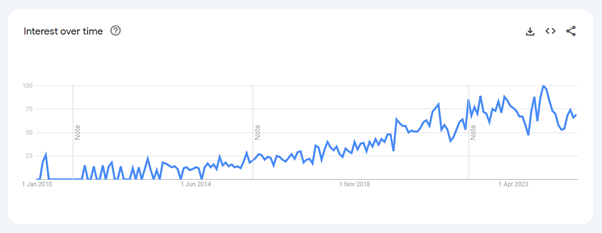Over the past decade, employee wellbeing has surged to the forefront of the HR zeitgeist; Googles searches increased by nearly 600% between 2014 and 2024:

From mindfulness workshops and mental health days to flexible working and financial wellbeing schemes, many companies have embraced a wide range of initiatives. Yet, despite these efforts, our research reveals a significant gap between provision and impact.
We found that 34% of companies still don’t have a robust wellbeing strategy and many simply don’t know where to begin [1]. Even among those that do, 24% of employees say they need more support with their mental health, and 30% feel their physical health needs are not being met [2].
These findings highlight a clear disconnect – while employers are increasingly active in the wellbeing space, employees continue to demand more meaningful, targeted support. Which raises an important question; if we’re investing more than ever in employee wellbeing, why does it still feel like we’re not getting it right?
Is data the missing piece?
The answer may not lie just in the existence of wellbeing strategies, but in how they are implemented and whether they truly resonate with employees. It’s one thing to offer a variety of generic benefits; it’s another to ensure those benefits are relevant, timely, and meet the evolving needs of your workforce.
A weekly yoga class might attract a handful of participants, but for many employees, more pressing concerns – such as mental health, financial stress, or caregiving responsibilities are going unmet. That’s where targeted, data-informed wellbeing strategies can make an impact. Organisations should strive to have a holistic data set across multiple varied success metrics, and our research shows opportunity for improvement in data aggregation and utilisation [1].

Surprisingly, a quarter of businesses don’t use data to measure the effectiveness of their wellbeing initiatives. Without insight into what’s working and what’s not, how can leaders confidently say their efforts are meaningful?
This gap may explain why many wellbeing initiatives fail to drive real engagement. Over a third of companies say they lack the time to focus on wellbeing [1] – highlighting the need for smarter, not harder, approaches. A robust wellbeing programme can have a far-reaching impact on both the lives of employees and organisational performance.
The ‘Whole Person’ approach:
Today’s employees may be juggling growing demands both professionally and personal, from childcare to caring for aging relatives, retirement planning to buying their first home – all amid a cost-of-living crisis that’s adding financial and emotional strain.
The CIPD’s latest Health and Wellbeing at Work [3] survey reports the highest level of sickness absence in over a decade – with stress, anxiety, and depression as major contributors. Over a quarter of employees say their job harms their mental health, and many feel under excessive pressure.
These challenges point to the need for a holistic, ‘whole person’ approach to wellbeing – one that recognises the interconnection between physical, mental, and emotional health, and supports individuals across all aspects of their lives.
Additionally, taking a preventative approach can be key in lessening the impact on a business from employee life events. Offering access to counselling through employee assistance programmes, psychotherapy sessions through health cash plans, and work-life support through employee benefits can all enable smooth transitions between work and non-work issues.
No Health Without Mental Health
Despite growing awareness and investment in wellbeing, mental health remains one of the most urgent – and often unmet – needs in the workplace. While many employers offer mental health days, mindfulness sessions, or EAPs, these often fall short of addressing the scale and complexity of what employees are facing.
Burnout, anxiety, and depression aren’t isolated experiences. Our research shows that a significant percentage of employees still feel their mental health needs are not adequately supported [2], and when mental health support is perceived as reactive, impersonal, or hard to access, it loses its ability to target the issue effectively.
In short, mental health shouldn’t be a pillar of wellbeing – it should be the foundation.
By prioritising workplace wellbeing, employers can create a positive work environment where employees feel valued, supported, and motivated to perform at their best.
Challenges faced by employers
Several barriers continue to hold companies back from making meaningful progress in wellbeing. A key challenge is the lack of line manager skills; many managers feel ill-equipped to handle mental health or wellbeing conversations, which limits their ability to offer timely and effective support [3]. Providing training can empower managers to recognise early warning signs, respond with empathy, and direct employees to appropriate resources.

Additionally, attraction and retention pressures are rising in today’s competitive talent market. Our research found that this is a top priority and challenge for companies in the next 3 years [1]. Addressing emerging risks early can be the key to staying competitive, a fifth of companies in our research said they select wellbeing initiatives to stay competitive, and this acts as a key motivator [1].
Increasing costs remain one of the most significant challenges companies face, especially as they navigate growing demands and constrained budgets. This creates a difficult balancing act between meeting business objectives and supporting employee needs. The lack of reliable data in the wellbeing makes return on investment difficult to quantify and weakens the overall business case.
To address this, companies can focus on reducing wasted spend by actively seeking and acting on employee feedback, ensuring that wellbeing initiatives are both targeted and impactful. By aligning investments with actual employee needs, organisations can drive better outcomes and build a stronger case for long-term wellbeing strategies.
Who can help?
Charities such as Mind or the Mental Health Foundation can be helpful when looking for free resources surrounding improving mental wellbeing and employee engagement. They also offer training courses and employer booklets, so HR departments can familiarise themselves with the issue at hand.
What can companies do next?
With almost half (49%) of employees saying they would leave their current role for a job with better benefits [2], it’s never been more important to meet their needs:
- Evaluate your current wellbeing offering, is it meeting employee needs?
- Gather employee feedback through focus groups and surveys
- Start leveraging data to support the business case for wellbeing initiatives
[1] Wellbeing Revolution Survey 2023
[2] Mind the Gap 2024
[3] CIPD, Health and Wellbeing at Work (2023) https://www.cipd.org/globalassets/media/knowledge/knowledge-hub/reports/2023-pdfs/8436-health-and-wellbeing-report-2023.pdf


